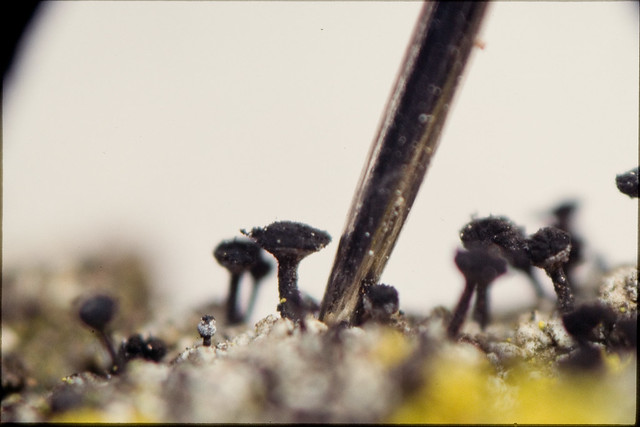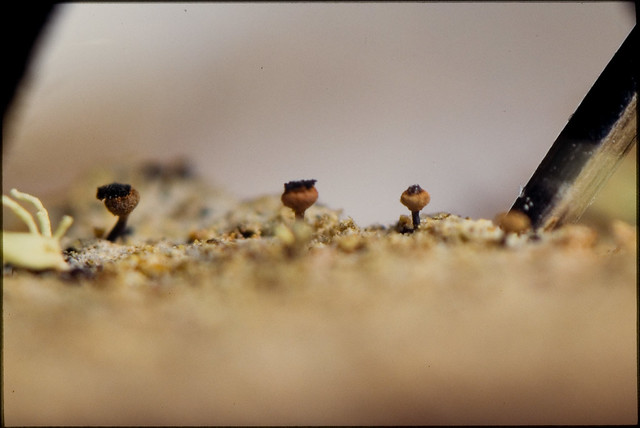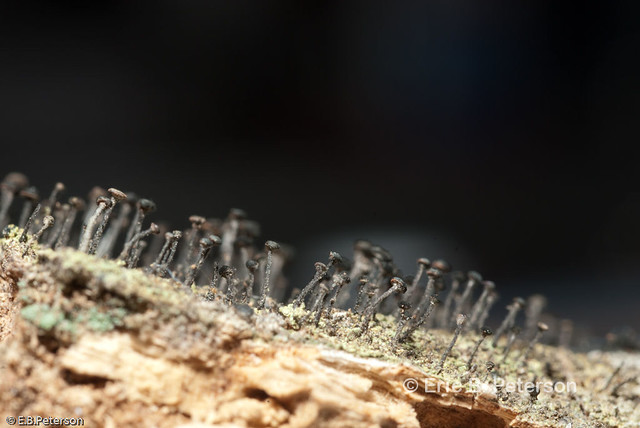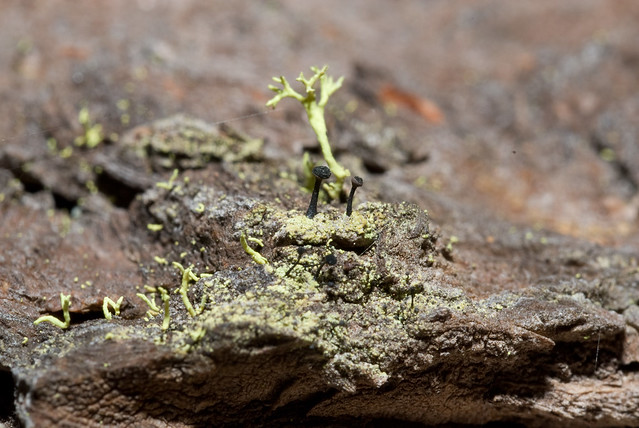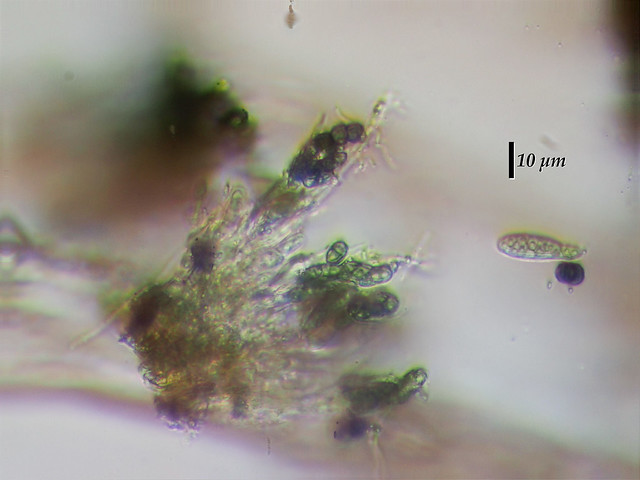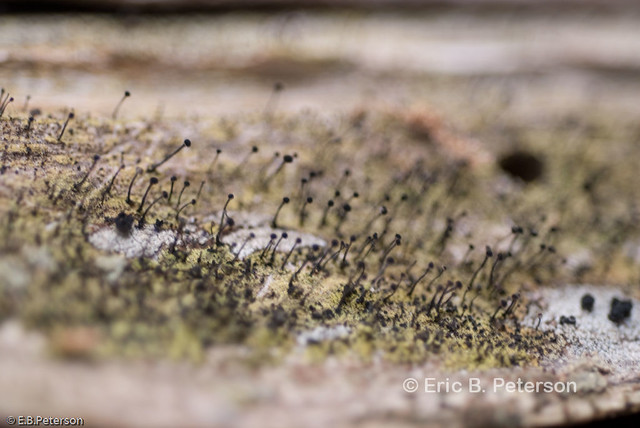- HOME
- Introduction
- History of "Caliciales" and the Origin of the "Calicioids"
- Biogeography of Calicioids
- Calicioid Ecology and Habitats
- Conservation
- Zen and the Search for Calicioids
- Collecting and Curating
- Key to Genera
- Acolium
- Acroscyphus
- Allocalicium
- Bruceomyces
- Calicium
- Chaenotheca
- Chaenothecopsis
- Cyphelium
- Cryptocalicium
- Microcalicium
- Mycocalicium
- Phaeocalicium
- Pseudothelomma
- Sclerophora
- Sphinctrina
- Stenocybe
- Texosporium
- Thelomma
- Tholurna
- "Within-bark"
- Glossary
- References
0.01 (development)
Eric B. Peterson
Calicium
Taxa covered (42):
Calicium adspersum ssp. adspersum
Calicium adspersum ssp. australe
Calicium brachysporum
Calicium bullatum
Calicium carolinianum
Calicium chlorosporum
Calicium constrictum
Calicium corynellum
Calicium denigratum
Calicium diploellum
Calicium glaucellum
Calicium hyperelloides
Calicium indicum
Calicium isabellinum
Calicium laevigatum
Calicium lecideinum
Calicium lenticulare
Calicium leucochlorum
Calicium lucidum
Calicium montanum
Calicium muriformis
Calicium nobile
Calicium notarisii
Calicium parvum
Calicium pinastri
Calicium pinicola
Calicium pluriseptatum
Calicium pyriforme
Calicium quercinum
Calicium robustellum
Calicium salicinum
Calicium sequoiae
Calicium tenuisporum
Calicium tigillare
Calicium trabinellum
Calicium trachylioides
Calicium tricolor
Calicium verrucosum
Calicium victorianum ssp. desidiosum
Calicium victorianum ssp. victorianum
Calicium viride
Key to Species
{WARNING: incomplete)
Validation script believes all taxa are included in the key(s).
- 1a. Described in Aptroot et al. (1997) (Sorry - I still lack a copy) and mentioned in Aptroot & Tibell (2003) as occurring only in Papua New Guinea.Calicium bullatum
-
-
- 3a. Thallus yellow to green; ascomata stalked, though generally < 0.7mm; sometimes with a faint yellowish pruina.Calicium corynellum
- 3b. Thallus grey; ascomata sessile (previously a member of Cyphelium).Calicium lecideinum
-
-
-
-
- 7a. Spores multiseptate (muriform).Calicium notarisii
-
- 8a. Mature spores 15-21 μm in length (smaller immature spores are often present, usually with less pigmentation); spore wall thick yet surface typically remaining smooth or nearly so (see discussion under C. brachysporum); broadly distributed in boreal regions, continuing southward in North America through the intermountain west.Calicium tigillare
- 8b. Spores 10-17 μm in length (smaller immature spores are often present, usually with less pigmentation); spore wall ornamented with a minute punctuate pattern (finely cracked into areoles) and some larger, more obvious cracks; apparently endemic to southern California.Calicium brachysporum
-
- 9a. Spores 13-17 μm long. Ascomata epruinose.Calicium pinicola
- 9b. Spores 17-22 μm long. Ascomata sometimes with a yellow pruina.Calicium lucidum
-
-
- 10a. Thallus immersed.Calicium victorianum (note subspecies below)
- 11a. Spores 10 - 12.5 μm; with a bumpy ornametation plus frequent irregular cracks; ascomata typically with a very short stalk.Calicium victorianum ssp. victorianum
- 11b. Spores larger, 13.4 - 16.3 μm, with infrequent irregular cracks.Calicium victorianum ssp. desidiosum
-
- 12a. Ascomata small (< 1 mm diameter). Thallus of poorly developed, brownish areolae, to sometimes immersed. Known from south-western North America and from Europe.Calicium trachylioides
- 12b. Ascomata sunken into thallus, sometimes fully immersed. Known only from south-eastern North America.Calicium carolinianum
-
-
- 13a. Thallus intensely yellow-green (rhizocarpic acid); ascomata well stalked. Growing on bark or wood. Ascomata typically > 0.7mm (often up to 2mm) and lacking pruina (though the reddish-brown excipulum can have disintegrating hyphae on the surface in older specimens that may resemble a reddish pruina). Thallus typically granular to verrucose, but sometimes just smooth and patchy. This is the most commonly collected Calicium.Calicium viride
- 13b. Thallus either immersed or superficial; perhaps with a pale yellowish color, but not intensely yellow-green.
- 14a. Ascomata with a yellow or yellowish-green pruina (in some cases this may be faint and mixed with the spores resulting in a greenish color to the mazaedium).
- 15a. Stalks short, typically < 0.3mm (or even sessile? Need to find descrip and clarify).Calicium diploellum
-
- 16a. Spores 8-11.5 longitudinal ridges maturing to irregular cracks. Asci cylindrical. Thallus immersed to thin verrucose, greyish green.Calicium trabinellum
-
- 17a. Ascospores 15-18 μm in length.Calicium nobile
-
- 18a. Thallus thick, apothecia short-stout, spores 12-14.5μm long.Calicium adspersum ssp. adspersum
- 18b. Thallus thin to immersed, apothecia tall, spores 9.5-11.5μm long.Calicium adspersum ssp. australe
-
-
- 20a. Spores forming multiple septa as they mature outside of the asci, becoming muriform. Growing over moss on large tree trunks. Known only from Japan (as of Tibell & Thor 2003).Calicium muriformis
- 20b. Spores with more than one septum (all longitudinal). Stalks pale. Known from only from Africa and Madagascar where it grows over moss on large trees.Calicium pluriseptatum
-
- 21a. Spore ornamentation of distinctly spirally arranged cracks. The spiral pattern can break up in well-aged spores, so a variety of spore development should be observed.
- 22a. Ascomata typically < 0.5mm tall, stalk dark gray to pale (especially toward base) but rarely a true black. Growing in exposed sites on hardwood twigs or young bark of conifers (where it may approach Tholurna dissimilis in appearance, but ascomata remain mostly < 2mm tall).Allocalicium adaequatum
- 22b. Ascomata often up to 1mm tall (or more) with a distinctly black stalk. Typically growing on bark or wood where protected from direct rainfall.
-
- 24a. Thallus immersed, often causing a grayish green color to wood. Gennerally K+ yellow to red (though may be weak), UV-.Calicium salicinum
-
- 25a. Thallus white to pale yellowish, C- and UV-. This step accounts for a weakly pigmented version of C. viride that is very infrequent, but sometimes develops in shaded sites.Calicium viride
-
- 26a. Thallus pale brownish-yellow to beige, C-, UV+ yellow. Mazaedium often with a yellow pruina. Spores 10.5-12.5μm long.Calicium chlorosporum
-
- 27a. Thallus pale straw-yellow, UV orange, C orange. Spores 11-14μm long. Reported from tropics of the western hemisphere.Calicium leucochlorum
- 27b. Thallus greenish grey, verrucose. Spores 10-12μm long. Reported from the eastern hemisphere.Calicium laevigatum
- 23b. Excipulum distinctly black (though possibly with white or yellow pruina concentrated on the rim), or if slightly brownish, then similarly colored to the stalk.
- 28a. Stalk I+ blue. Thallus verrucose, yellowish to greenish, K yellow.Calicium sequoiae
-
- 29a. Stalk with brownish pigments. Pruina on excipulum typically quite white. Known from multiple continents [but quite rare in the Pacific Northwest].Calicium quercinum
- 29b. Stalk with aeruginose hyphae. Capitulum typically with a brown to grayish pruina on the lower side of the excipulum. Known only from India.Calicium tenuisporum
- 29c. SThallus verrucose to squamulose, pale grayish to reddish brown. Often thin grayish pruina. Spores 11-12.5, with spiral orn esp when young (Tibell 2006 notes peculiar forking of the spiral ridges). Known only from the Himalaya.Calicium indicum
-
-
-
- 31a. Mature spores 5.5 - 8 μm long with an ornamentation of minute dots. Excipular rim strongly constricted. Excipulum epruinose, but slightly grayish on rim.Calicium constrictum
- 31b. Mature spores > 8μm long and with an ornamentation of irregular cracks. Excipular rim not strongly constricted. Pruina variable.
-
- 33a. [NEED DISTINCTION] Mature spores 9-14μm. Excipulum epruinose. Thallus immersed to thin and grayish-green.Calicium pinastri
- 33b. Thallus immersed; stalks sessile or nearly so.Calicium victorianum (note subspecies below)
- 34a. Spores 10 - 12.5 μm; with a bumpy ornametation plus frequent irregular cracks; ascomata typically with a very short stalk.Calicium victorianum ssp. victorianum
- 34b. Spores larger, 13.4 - 16.3 μm, with infrequent irregular.Calicium victorianum ssp. desidiosum
-
- 35a. # Excipulum epruinose but mazaeidium sometimes has a faint white pruina; spores 12.5 - 15.5; thallus verrucose to nearly immersed, straw yellow to greenish yellow, C orange; stalk 0.3 - 0.6 mm tall, stout.Calicium robustellum
- 35b. Spores 13-16 μm in length.Calicium verrucosum
-
- 36a. Mature spores 9-14μm. Excipulum epruinose. Thallus thin and grayish-green, or immersed.Calicium pinastri
- 36b. Mature spores 9-12μm long. Excipulum white-pruinose. Thallus typically thick granular to verrucose, greenish-gray.Calicium montanum
-
-
- 37a. Ascomata, capitula, and mazaedium completely lacking pruina (entirely black or dark brown and often glossy).
- 38a. Ascomata never pruinose; black and often glossy. Asci cylindrical. Spores 11-14 μm long, minutely areolate.Calicium denigratum
- 38b. # [sometimes described as having occasionally olive-brown stalks (Tibell 1998 under C. tricolor)]. Asci cylindrical. Spores 13 - 15 μm long, minutely areolate.Calicium abietinum
- 38c. # epru to white, spores 11.5-14.7μm long.Calicium isabellinum
- 37b. Stalks, capitula, and mazaedia with some degree of pruina, crystalization, or similar phenomena producing a white, gray, or yellowish substance somewhere; glossy or not.
-
- 40a. Thallus verrucose, generally pale gray-green, K-. Outer sheath of stalk I purplish. Spiral ornamentation visible mainly in young spores, becoming obscured by bumpy ornamentation with maturity [Tibell does not always mention the spiral - citation would be nice], 11-12 μm long.Calicium lenticulare
-
-
- 42a. Thallus whitish to greenish gray; Tibell (1999) describes as verrucose and sometimes confluent, although the thallus can be effectively immersed in western North American material. Asci clavate (and sufficiently persistent to be reliably found in squash mounts). Spores 8-10 μm long, with an irregular ornamentation.Calicium parvum
- 42b. Thallus white to gray, verrucose with a granular surface, K+ yellow, C-, PD-. Asci pyriform. Spores 9 - 10.5 μm, with a minute areolate ornamentation.Calicium pyriforme
-
- 43a. Thallus verrucose, yellowish/greenish, K+ yellowish, C+ orange, KC+ orange, PD-, UV+ dark orange. Capitulum epruinose to having a slight gray rim and sometimes a yellowish zone of minute crystals at the edge of the hymenium. Asci cylindrical. Spores 10.5 - 14 μm long, minutely cracked. Tropical to subtropical.Calicium hyperelloides
- 43b. Thallus immersed to thinly verrucose, white to grayish green. Asci cylindrical. Spores 9-11 μm long, Tibell (1999) describes longitudinal ridging in young spores becoming disrupted by irregular cracks.Calicium glaucellum
- 43c. # Thallus verrucose to immersed, yellowish brownish, K+ dull yellow, C+orange, KC+ orange, P-, UV+ dark orange (arthothelin and thiophanic acids). White pruina that is P+ orange (undetermined substance), on most (but not all) capitula.Spores 10-13.5 long, minutely areolate ornamentation.Calicium tricolor
-
-
-
-
-
-
Step number 35 has 3 options!
Step number 38 has 3 options!
Step number 40 has 1 options!
Step number 43 has 3 options!
Species Details
ID=3
Type(s): Tent. disp. meth. fung. (Lipsiae): 59 (1797)
Synonyms:
Habit and Morphology:
Anatomy:
Chemistry:
Habitat:
Biogeography:
Global Rank:
Conservation:
Notes:
External Information:
 Index Fungorum: ID=380946
Index Fungorum: ID=380946 Encyclopedia of Life (EOL): Search
Encyclopedia of Life (EOL): Search - CNALH: Search
- NatureServe:
 ODBaL Search
ODBaL SearchNucleotide Search
ID=5
Type(s):
Synonyms:
Habit and Morphology:
Anatomy:
Chemistry:
Habitat:
Biogeography:
Global Rank:
Conservation:
Notes:
External Information:
 Index Fungorum: ID=
Index Fungorum: ID= Encyclopedia of Life (EOL): Search
Encyclopedia of Life (EOL): Search - CNALH: Search
- NatureServe:
 ODBaL Search
ODBaL SearchNucleotide Search
ID=6
Type(s):
Synonyms:
Habit and Morphology:
Anatomy:
Chemistry:
Habitat:
Biogeography:
Global Rank:
Conservation:
Notes:
External Information:
 Index Fungorum: ID=
Index Fungorum: ID= Encyclopedia of Life (EOL): Search
Encyclopedia of Life (EOL): Search - CNALH: Search
- NatureServe:
 ODBaL Search
ODBaL SearchNucleotide Search
ID=213
Type(s):
Synonyms:
Habit and Morphology:
Ascomata immersed in thallus areoles.
Anatomy:
Ascospores septate, ellipsoid to nearly spherical with only minor narrowing at the septum, strongly pigmented brown. The wal of the spores is quite thick and typically exhibits fine cracking into areolate/punctate patterns at maturity. Larger deeper cracks may also be present.
Chemistry:
Habitat:
Biogeography:
Endemic to south-central California.
Global Rank:
Conservation:
Proposed for IUCN Global Red List.
Notes:
This taxon is clearly a very close relative of C. tigillare. Although litterature describes the spores of C. tigillare as larger than those of C. brachysporum, my limited experience suggests they have siubstantial overlap in their size ranges. In my preliminary opinion (and I really need to view more specimens to make this statement with certainty), these would be better distinguished on the spore wall ornamentation. C. tigillare has smooth spores or just a little random cracking whereas C. brachysporium has much of the spores covered with fine cracks that give it an areolate or punctate appearance.
The other distinguishing factor may be their range. C. tigillare is a boreal species that comes southward in arid regions such as the intermountain west of North America (cool deserts). C. brachysporium is exclusively known from southern California where it is found in oak savannas of a mediterranian climate. While this habitat can be dry, it is certainly warmer, and through much of the lichen growing season (winter) is much more humid, than the intermountain west. Indeed it often grows adjacent to luxurient growths of Ramalina menziesii, indicating a significant presence of fog. Montane areas between the southern California oaks and the intermountain west (e.g. the Sierra, Cascade, and Klamath Mountains) have little, if any C. tigillare; rather the most appropriate habitats are taken by C. pinicola instead. Indeed, it seems unlikely that C. tigillare and C. brachysporum would be synonymized in that it would form a taxon that occurs in two rather different climates while skipping over intermediate areas.
C. tigillare is regularly reported from southern California as well; I suggest that these should be closely reexamined with attention to the spore ornamentation distinction I postulate here.
Perhaps of further interest, C. tigillare in the intermountain west can have either nearly spherical spores, or more distinctly elipsoidal spores as are typical for Calicium.
External Information:
 Index Fungorum: ID=365874
Index Fungorum: ID=365874 Encyclopedia of Life (EOL): Search
Encyclopedia of Life (EOL): Search - CNALH: Search
- NatureServe:
 ODBaL Search
ODBaL SearchNucleotide Search
ID=229
Type(s): Aptroot, Diederich, Sérusiaux & Sipman, Biblthca Lichenol. 64: 41 (1997)
Synonyms:
Habit and Morphology:
Anatomy:
Chemistry:
Habitat:
Biogeography:
Global Rank:
Conservation:
Notes:
External Information:
 Index Fungorum: ID=
Index Fungorum: ID= Encyclopedia of Life (EOL): Search
Encyclopedia of Life (EOL): Search - CNALH: Search
- NatureServe:
 ODBaL Search
ODBaL SearchNucleotide Search
ID=242
Type(s):
Synonyms:
Habit and Morphology:
Anatomy:
Chemistry:
Habitat:
Biogeography:
Global Rank:
Conservation:
Notes:
External Information:
 Index Fungorum: ID=
Index Fungorum: ID= Encyclopedia of Life (EOL): Search
Encyclopedia of Life (EOL): Search - CNALH: Search
- NatureServe:
 ODBaL Search
ODBaL SearchNucleotide Search
ID=7
Type(s):
Synonyms:
Habit and Morphology:
Anatomy:
Chemistry:
Habitat:
Biogeography:
Global Rank:
Conservation:
Notes:
External Information:
 Index Fungorum: ID=
Index Fungorum: ID= Encyclopedia of Life (EOL): Search
Encyclopedia of Life (EOL): Search - CNALH: Search
- NatureServe:
 ODBaL Search
ODBaL SearchNucleotide Search
ID=8
Type(s):
Synonyms:
Habit and Morphology:
Anatomy:
Chemistry:
Habitat:
Biogeography:
Global Rank:
Conservation:
Notes:
External Information:
 Index Fungorum: ID=
Index Fungorum: ID= Encyclopedia of Life (EOL): Search
Encyclopedia of Life (EOL): Search - CNALH: Search
- NatureServe:
 ODBaL Search
ODBaL SearchNucleotide Search
ID=9
Type(s):
Synonyms:
Habit and Morphology:
Anatomy:
Chemistry:
Habitat:
Biogeography:
Global Rank:
Conservation:
Notes:
External Information:
 Index Fungorum: ID=
Index Fungorum: ID= Encyclopedia of Life (EOL): Search
Encyclopedia of Life (EOL): Search - CNALH: Search
- NatureServe:
 ODBaL Search
ODBaL SearchNucleotide Search
ID=10
Type(s):
Synonyms:
Habit and Morphology:
Anatomy:
Chemistry:
Habitat:
Biogeography:
Global Rank:
Conservation:
Notes:
External Information:
 Index Fungorum: ID=
Index Fungorum: ID= Encyclopedia of Life (EOL): Search
Encyclopedia of Life (EOL): Search - CNALH: Search
- NatureServe:
 ODBaL Search
ODBaL SearchNucleotide Search
ID=11
Type(s):
Synonyms:
Habit and Morphology:
Anatomy:
Chemistry:
Habitat:
Biogeography:
Global Rank:
Conservation:
Notes:
External Information:
 Index Fungorum: ID=
Index Fungorum: ID= Encyclopedia of Life (EOL): Search
Encyclopedia of Life (EOL): Search - CNALH: Search
- NatureServe:
 ODBaL Search
ODBaL SearchNucleotide Search
ID=12
Type(s):
Synonyms:
Habit and Morphology:
Usually immersed; if superficial then thin, pale gray to dark greenish gray, becoming verrucose.
Anatomy:
Asci cylindrical (spores uniseriate).
Ascospores 9 - 13 µm, ornamented with minute longitudinal ridges combined with irregular cracking (see Tibell 1999).
Chemistry:
Habitat:
Biogeography:
Global Rank:
Conservation:
Notes:
External Information:
 Index Fungorum: ID=
Index Fungorum: ID= Encyclopedia of Life (EOL): Search
Encyclopedia of Life (EOL): Search - CNALH: Search
- NatureServe:
 ODBaL Search
ODBaL SearchNucleotide Search
ID=13
Type(s):
Synonyms:
Habit and Morphology:
Anatomy:
Chemistry:
Habitat:
Biogeography:
Global Rank:
Conservation:
Notes:
External Information:
 Index Fungorum: ID=
Index Fungorum: ID= Encyclopedia of Life (EOL): Search
Encyclopedia of Life (EOL): Search - CNALH: Search
- NatureServe:
 ODBaL Search
ODBaL SearchNucleotide Search
ID=14
Type(s):
Synonyms:
Habit and Morphology:
Anatomy:
Chemistry:
Habitat:
Biogeography:
Global Rank:
Conservation:
Notes:
External Information:
 Index Fungorum: ID=
Index Fungorum: ID= Encyclopedia of Life (EOL): Search
Encyclopedia of Life (EOL): Search - CNALH: Search
- NatureServe:
 ODBaL Search
ODBaL SearchNucleotide Search
ID=15
Type(s): Tibell 1998
Synonyms:
Habit and Morphology: Lichenized. Thallus superficial to immersed, yellowish. Mostly 0.5-1mm, but often with some shorter stalks.
Anatomy: Cylindrical. 11.5-14.7 x 5.8-8.5, ornamentation of "minute polygonal areas and in ageing spores with coarse irregular cracks" (Tibell 1998).
Chemistry: Thallus K-, C- KC+ pale orange, P-, UV-: Isousnic acid.
Habitat:
Biogeography: Known only from type locality in Chile as of Tibell 1998.
Global Rank:
Conservation:
Notes:
External Information:
 Index Fungorum: ID=
Index Fungorum: ID= Encyclopedia of Life (EOL): Search
Encyclopedia of Life (EOL): Search - CNALH: Search
- NatureServe:
 ODBaL Search
ODBaL SearchNucleotide Search
ID=16
Type(s): Tibell 2006:
Synonyms:
Habit and Morphology: Lichenized. Episubstratic, verrucose, greenish grey. Ascomata tall, > 1mm. Excipulum brownish, K+ red.
Anatomy: Asci cylindrical. Mature spores 10-12μm long with a spiral ornamentation when young, becoming more irregular at maturity.
Chemistry: Thallus K+ yellow turning red, P+ yellow to orange. Alectorialic, barbatolic, hypoalectorialic, and norstictic acids.
Habitat: Old forests of Quercus and Quercus-coniferous mixes. Known from bark of Quercus, Abies, and Tsuga
Biogeography: Known only from the Himalayas thus far.
Global Rank:
Conservation:
Notes:
External Information:
 Index Fungorum: ID=
Index Fungorum: ID= Encyclopedia of Life (EOL): Search
Encyclopedia of Life (EOL): Search - CNALH: Search
- NatureServe:
 ODBaL Search
ODBaL SearchNucleotide Search
ID=218
Type(s):
Synonyms:
Habit and Morphology:
Anatomy:
Chemistry:
Habitat:
Biogeography:
Global Rank:
Conservation:
Notes: listed in Tibell's checklist (1999), "NH-EUR"
External Information:
 Index Fungorum: ID=
Index Fungorum: ID= Encyclopedia of Life (EOL): Search
Encyclopedia of Life (EOL): Search - CNALH: Search
- NatureServe:
 ODBaL Search
ODBaL SearchNucleotide Search
ID=17
Type(s):
Synonyms:
Calicium subquercinum Asahina (see Index Fungorum)
Habit and Morphology:
Anatomy:
Chemistry:
Habitat:
Biogeography:
Global Rank:
Conservation:
Notes:
External Information:
 Index Fungorum: ID=
Index Fungorum: ID= Encyclopedia of Life (EOL): Search
Encyclopedia of Life (EOL): Search - CNALH: Search
- NatureServe:
 ODBaL Search
ODBaL SearchNucleotide Search
ID=18
Type(s):
Synonyms:
Habit and Morphology:
Anatomy:
Chemistry:
Habitat:
Biogeography:
Global Rank:
Conservation:
Notes:
External Information:
 Index Fungorum: ID=
Index Fungorum: ID= Encyclopedia of Life (EOL): Search
Encyclopedia of Life (EOL): Search - CNALH: Search
- NatureServe:
 ODBaL Search
ODBaL SearchNucleotide Search
ID=219
Type(s):
Synonyms:
Habit and Morphology:
Anatomy:
Chemistry:
Habitat:
Biogeography:
Global Rank:
Conservation:
Notes:
External Information:
 Index Fungorum: ID=
Index Fungorum: ID= Encyclopedia of Life (EOL): Search
Encyclopedia of Life (EOL): Search - CNALH: Search
- NatureServe:
 ODBaL Search
ODBaL SearchNucleotide Search
ID=19
Type(s): Tibell 1999 Mycotaxon 70: 431-443
Synonyms:
2-Edit.jpg)

Habit and Morphology: Lichenized. Grannular to verrucose, grayish to greenish. Ascomata short-stalked, <0.5mm tall, excipular rim white pruinose.
Anatomy: Cylindrical. Mature spores 9-12μm long with an irregularly cracked ornamentation.
Chemistry: K- C- KC- P- I-, divaricatic and 2-O-methyldivaricatic acids
Habitat: Drier, open forests and woodlands, on wood of Quercus, Juniperus, Pinus and other phorophytes.
Biogeography: Africa, Europe, and North America.
Global Rank:
Conservation:
Notes: [[[add citation of Sonoran Flora]]]
External Information:
 Index Fungorum: ID=
Index Fungorum: ID= Encyclopedia of Life (EOL): Search
Encyclopedia of Life (EOL): Search - CNALH: Search
- NatureServe:
 ODBaL Search
ODBaL SearchNucleotide Search
ID=20
Type(s):
Synonyms:
Habit and Morphology:
Anatomy:
Chemistry:
Habitat:
Biogeography:
Global Rank:
Conservation:
Notes:
External Information:
 Index Fungorum: ID=
Index Fungorum: ID= Encyclopedia of Life (EOL): Search
Encyclopedia of Life (EOL): Search - CNALH: Search
- NatureServe:
 ODBaL Search
ODBaL SearchNucleotide Search
ID=21
Type(s):
Synonyms:
Habit and Morphology:
Anatomy:
Chemistry:
Habitat:
Biogeography:
Global Rank:
Conservation:
Notes:
External Information:
 Index Fungorum: ID=
Index Fungorum: ID= Encyclopedia of Life (EOL): Search
Encyclopedia of Life (EOL): Search - CNALH: Search
- NatureServe:
 ODBaL Search
ODBaL SearchNucleotide Search
ID=221
Type(s):
Synonyms:
Habit and Morphology:
Anatomy:
Chemistry:
Habitat:
Biogeography:
Global Rank:
Conservation:
Notes:
External Information:
 Index Fungorum: ID=
Index Fungorum: ID= Encyclopedia of Life (EOL): Search
Encyclopedia of Life (EOL): Search - CNALH: Search
- NatureServe:
 ODBaL Search
ODBaL SearchNucleotide Search
ID=22
Type(s):
Synonyms:
Habit and Morphology:
Anatomy:
Chemistry:
Habitat:
Biogeography:
Global Rank:
Conservation:
Notes:
External Information:
 Index Fungorum: ID=
Index Fungorum: ID= Encyclopedia of Life (EOL): Search
Encyclopedia of Life (EOL): Search - CNALH: Search
- NatureServe:
 ODBaL Search
ODBaL SearchNucleotide Search
ID=23
Type(s):
Synonyms:
Habit and Morphology:
Anatomy:
Chemistry:
Habitat:
Biogeography:
Global Rank:
Conservation:
Notes:
External Information:
 Index Fungorum: ID=
Index Fungorum: ID= Encyclopedia of Life (EOL): Search
Encyclopedia of Life (EOL): Search - CNALH: Search
- NatureServe:
 ODBaL Search
ODBaL SearchNucleotide Search
ID=222
Type(s):
Synonyms:
Habit and Morphology: Thallus intensely yellow to yellow-green; verrucose to almost immersed. Ascomata sessile to partially immersed, < 1 mm diameter..
Anatomy: Ascospores 14-16 um long, developing irregular cracks at maturity.
Chemistry:
Habitat:
Biogeography:
Global Rank:
Conservation:
Notes:
External Information:
 Index Fungorum: ID=
Index Fungorum: ID= Encyclopedia of Life (EOL): Search
Encyclopedia of Life (EOL): Search - CNALH: Search
- NatureServe:
 ODBaL Search
ODBaL SearchNucleotide Search
ID=24
Type(s):
Synonyms:
Habit and Morphology:
Anatomy:
Chemistry:
Habitat:
Biogeography:
Global Rank:
Conservation:
Notes:
External Information:
 Index Fungorum: ID=
Index Fungorum: ID= Encyclopedia of Life (EOL): Search
Encyclopedia of Life (EOL): Search - CNALH: Search
- NatureServe:
 ODBaL Search
ODBaL SearchNucleotide Search
ID=25
Type(s):
Synonyms:
Habit and Morphology:
Anatomy:
Chemistry:
Habitat:
Biogeography:
Global Rank:
Conservation:
Notes:
External Information:
 Index Fungorum: ID=
Index Fungorum: ID= Encyclopedia of Life (EOL): Search
Encyclopedia of Life (EOL): Search - CNALH: Search
- NatureServe:
 ODBaL Search
ODBaL SearchNucleotide Search
ID=26
Type(s):
Synonyms:
Habit and Morphology:
Anatomy:
Chemistry:
Habitat:
Biogeography:
Global Rank:
Conservation:
Notes:
External Information:
 Index Fungorum: ID=
Index Fungorum: ID= Encyclopedia of Life (EOL): Search
Encyclopedia of Life (EOL): Search - CNALH: Search
- NatureServe:
 ODBaL Search
ODBaL SearchNucleotide Search
ID=27
Type(s):
Synonyms:
Habit and Morphology: Thallus verrucose to almost immersed, dull yellow to greenish yellow. Ascomata short but very stout, < 0.6 um tall, epruinose.
Anatomy: Stalk with a pale outer layer. Ascospores 12.5 - 15.5 um long, ornamented by minute bumps.
Chemistry: I-.
Habitat:
Biogeography:
Global Rank:
Conservation:
Notes:
External Information:
 Index Fungorum: ID=
Index Fungorum: ID= Encyclopedia of Life (EOL): Search
Encyclopedia of Life (EOL): Search - CNALH: Search
- NatureServe:
 ODBaL Search
ODBaL SearchNucleotide Search
ID=28
Type(s):
Synonyms:
Habit and Morphology:
Anatomy:
Chemistry:
Habitat:
Biogeography:
Global Rank:
Conservation:
Notes:
External Information:
 Index Fungorum: ID=
Index Fungorum: ID= Encyclopedia of Life (EOL): Search
Encyclopedia of Life (EOL): Search - CNALH: Search
- NatureServe:
 ODBaL Search
ODBaL SearchNucleotide Search
ID=29
Type(s):
Synonyms:
Habit and Morphology:
Anatomy:
Chemistry:
Habitat:
Biogeography:
Global Rank:
Conservation:
Notes:
External Information:
 Index Fungorum: ID=
Index Fungorum: ID= Encyclopedia of Life (EOL): Search
Encyclopedia of Life (EOL): Search - CNALH: Search
- NatureServe:
 ODBaL Search
ODBaL SearchNucleotide Search
ID=30
Type(s):
Synonyms:
Habit and Morphology:
Anatomy:
Chemistry:
Habitat:
Biogeography:
Global Rank:
Conservation:
Notes:
External Information:
 Index Fungorum: ID=548374
Index Fungorum: ID=548374 Encyclopedia of Life (EOL): Search
Encyclopedia of Life (EOL): Search - CNALH: Search
- NatureServe:
 ODBaL Search
ODBaL SearchNucleotide Search
ID=224
Type(s):
Synonyms:

Habit and Morphology:
Thallus areolate, bright yellow.
Ascomata immersed such that the rim of the excipulum is typically not visible in a dissecting scope.
Anatomy:
Chemistry:
Habitat:
Biogeography:
Global Rank:
Conservation:
Notes:
External Information:
 Index Fungorum: ID=
Index Fungorum: ID= Encyclopedia of Life (EOL): Search
Encyclopedia of Life (EOL): Search - CNALH: Search
- NatureServe:
 ODBaL Search
ODBaL SearchNucleotide Search
ID=31
Type(s):
Synonyms:
Habit and Morphology:
Anatomy:
Chemistry:
Habitat:
Biogeography:
Global Rank:
Conservation:
Notes:
External Information:
 Index Fungorum: ID=
Index Fungorum: ID= Encyclopedia of Life (EOL): Search
Encyclopedia of Life (EOL): Search - CNALH: Search
- NatureServe:
 ODBaL Search
ODBaL SearchNucleotide Search
ID=225
Type(s):
Synonyms:
Habit and Morphology:
Anatomy:
Chemistry:
Habitat:
Biogeography:
Global Rank:
Conservation:
Notes:
External Information:
 Index Fungorum: ID=
Index Fungorum: ID= Encyclopedia of Life (EOL): Search
Encyclopedia of Life (EOL): Search - CNALH: Search
- NatureServe:
 ODBaL Search
ODBaL SearchNucleotide Search
ID=32
Type(s):
Synonyms:
Habit and Morphology:
Anatomy:
Chemistry:
Habitat:
Biogeography:
Global Rank:
Conservation:
Notes:
External Information:
 Index Fungorum: ID=
Index Fungorum: ID= Encyclopedia of Life (EOL): Search
Encyclopedia of Life (EOL): Search - CNALH: Search
- NatureServe:
 ODBaL Search
ODBaL SearchNucleotide Search
ID=33
Type(s):
Synonyms:
Habit and Morphology:
Anatomy:
Chemistry:
Habitat:
Biogeography:
Global Rank:
Conservation:
Notes:
External Information:
 Index Fungorum: ID=
Index Fungorum: ID= Encyclopedia of Life (EOL): Search
Encyclopedia of Life (EOL): Search - CNALH: Search
- NatureServe:
 ODBaL Search
ODBaL SearchNucleotide Search
ID=35
Type(s):
Synonyms:
Habit and Morphology: Thallus immersed.
Anatomy: Epruinose. Ascospores septate, 13.4 - 16.3 um long, ornamentation of a few irregular cracks with maturity.
Chemistry:
Habitat:
Biogeography:
Global Rank:
Conservation:
Notes:
External Information:
 Index Fungorum: ID=
Index Fungorum: ID= Encyclopedia of Life (EOL): Search
Encyclopedia of Life (EOL): Search - CNALH: Search
- NatureServe:
 ODBaL Search
ODBaL SearchNucleotide Search
ID=34
Type(s):
Synonyms:
Habit and Morphology: Thallus immersed. Ascomata very short stalked to roughly sessile.
Anatomy: Ascospores septate, 10 - 12.5 um long, ornamentation of irregular bumps sometimes forming ridges, plus irregular cracks with maturity.
Chemistry:
Habitat:
Biogeography:
Global Rank:
Conservation:
Notes:
External Information:
 Index Fungorum: ID=
Index Fungorum: ID= Encyclopedia of Life (EOL): Search
Encyclopedia of Life (EOL): Search - CNALH: Search
- NatureServe:
 ODBaL Search
ODBaL SearchNucleotide Search
ID=36
Type(s):
Synonyms:
Habit and Morphology:
Anatomy:
Chemistry:
Habitat:
Biogeography:
Global Rank:
Conservation:
Notes:
External Information:
 Index Fungorum: ID=
Index Fungorum: ID= Encyclopedia of Life (EOL): Search
Encyclopedia of Life (EOL): Search - CNALH: Search
- NatureServe:
 ODBaL Search
ODBaL SearchNucleotide Search
Count of taxa = 42

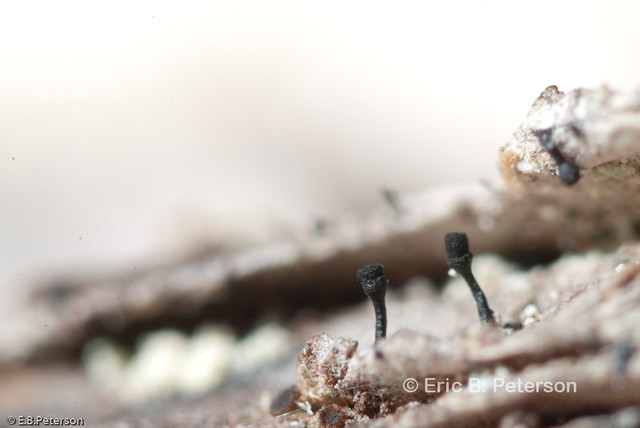
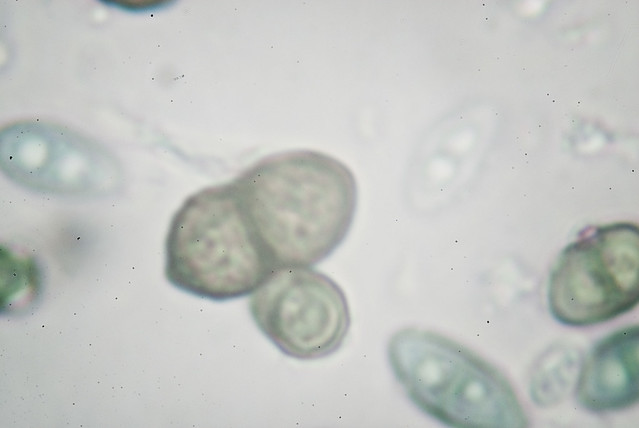
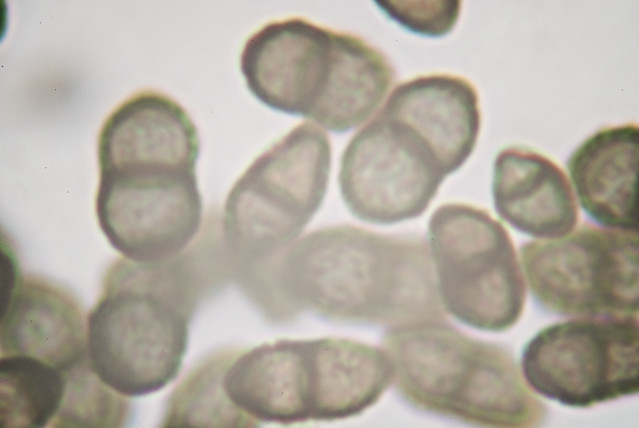



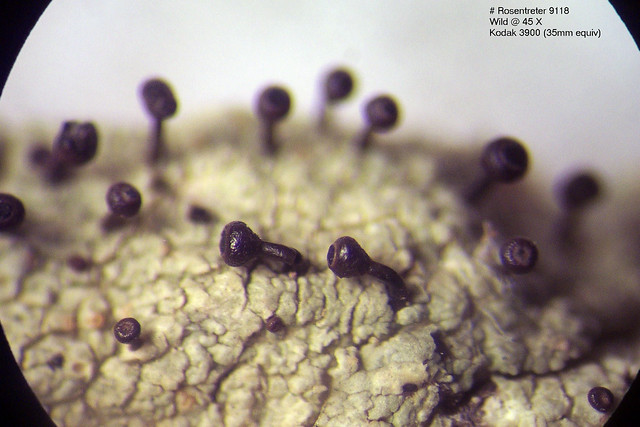

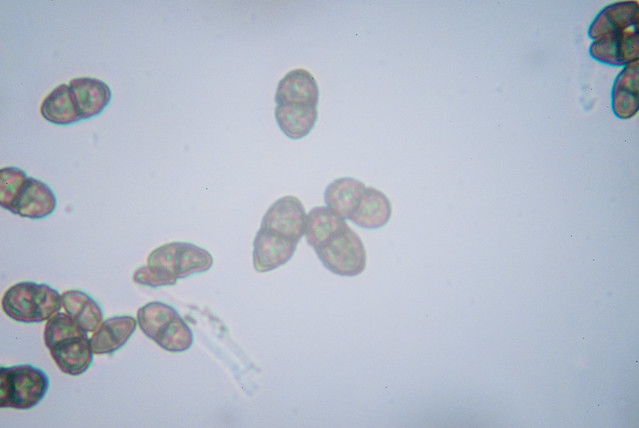
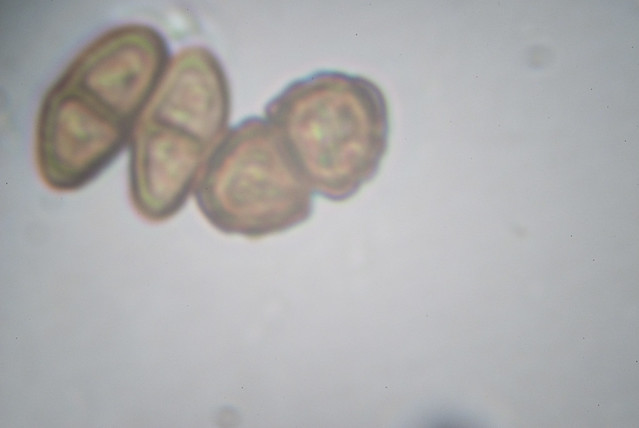
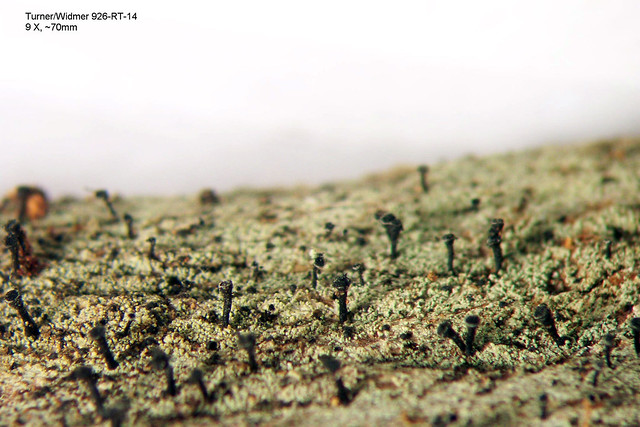
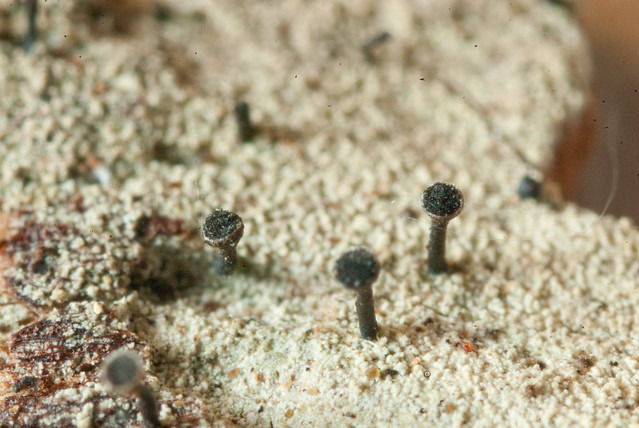

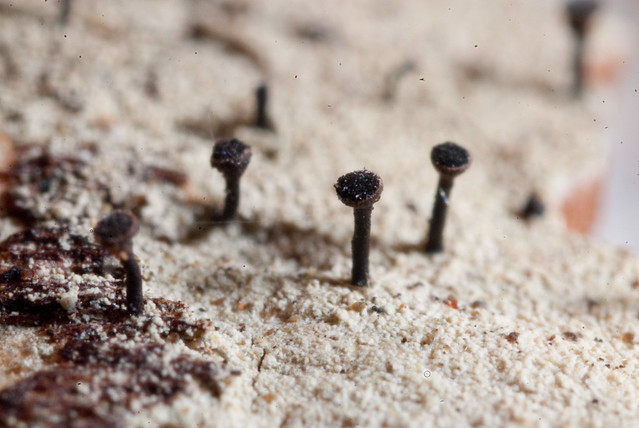





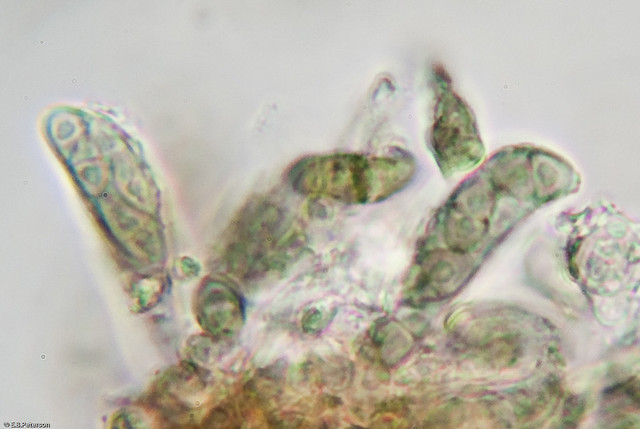
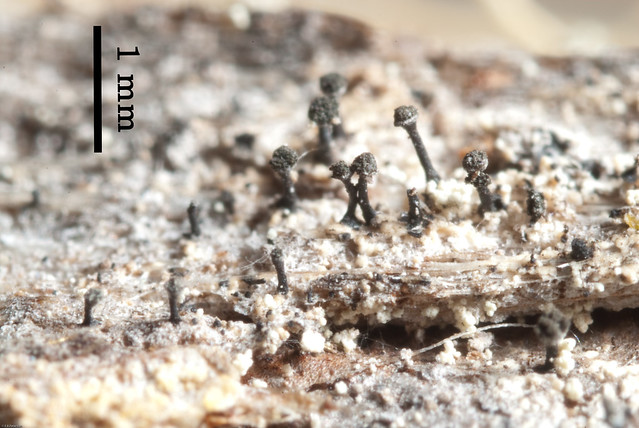

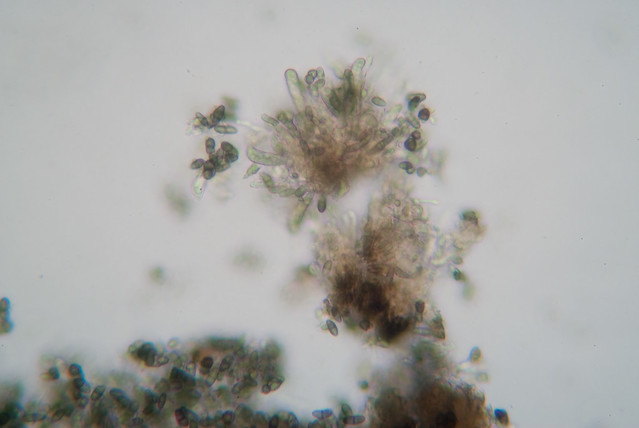
-Edit.jpg)
-Edit.jpg)

-Edit.jpg)




